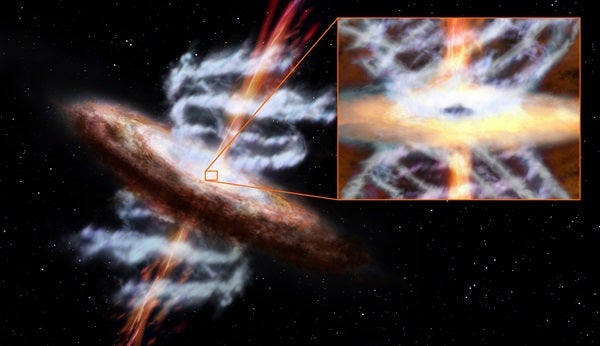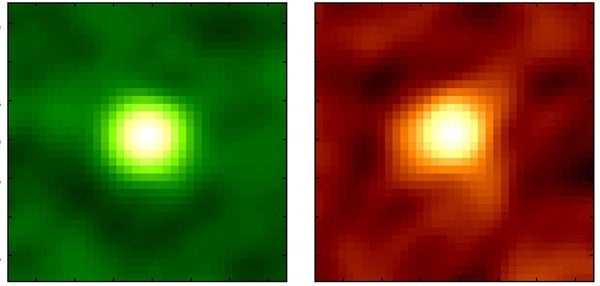A team led by Yoshiki Toba of the Academia Sinica Institute of Astronomy and Astrophysics has used the Atacama Large Millimeter/submillimeter Array (ALMA) to observe a set of dust-obscured galaxies (DOGs) that give off bright infrared emission. DOGs are believed to harbor black holes currently undergoing growth spurts, which typically spur outflows from the region around the feasting black hole. In one such galaxy, WISE1029, they observed that carbon monoxide (CO) gas in the galaxy’s disk, a crucial star-forming ingredient, was not affected by outflowing ionized gas (gas whose atoms have been stripped of electrons by strong radiation) from the central supermassive black hole. The total lack of a connection goes against current theory, which states that outflows should affect such star-forming gas, either by activating star formation or by stopping it. Their result was published December 18 in the Astrophysical Journal.
“It has made the co-evolution of galaxies and supermassive black holes more puzzling,” said Yoshiki in a press release.
This is an odd result — outflows of ionized gas are frequently detected from supermassive black holes, but this is the first time the outflow has not been connected to a change in the galaxy’s molecular gas. Such an outlier suggests that astronomers cannot automatically assume such outflows will always change or quench star formation, and casts doubt on the idea that galaxies and their central supermassive black holes co-evolve in a simple way. One possibility is the outflow from the black hole may be shooting out perpendicular to the molecular gas in the disk, preventing the two from interacting — data from the Sloan Digital Sky Survey indicates that the black hole’s outflow of ionized gas is pointed directly toward Earth. So perhaps a specific orientation is needed to either cause or prevent interaction between the two.
“Astronomers do not understand the real relation between the activity of supermassive black holes and star formation in galaxies,” said co-author Tohru Nagao of Ehime University. Indeed, it is one of the outstanding mysteries in the field of galaxy evolution, and one astronomers are focusing in on as the ability to observe details within single galaxies continues to improve.
“Understanding such co-evolution is crucial for astronomy,” Yoshiki said. “By collecting statistical data of this kind of galaxies and continuing in more follow-up observations using ALMA, we hope to reveal the truth.”











